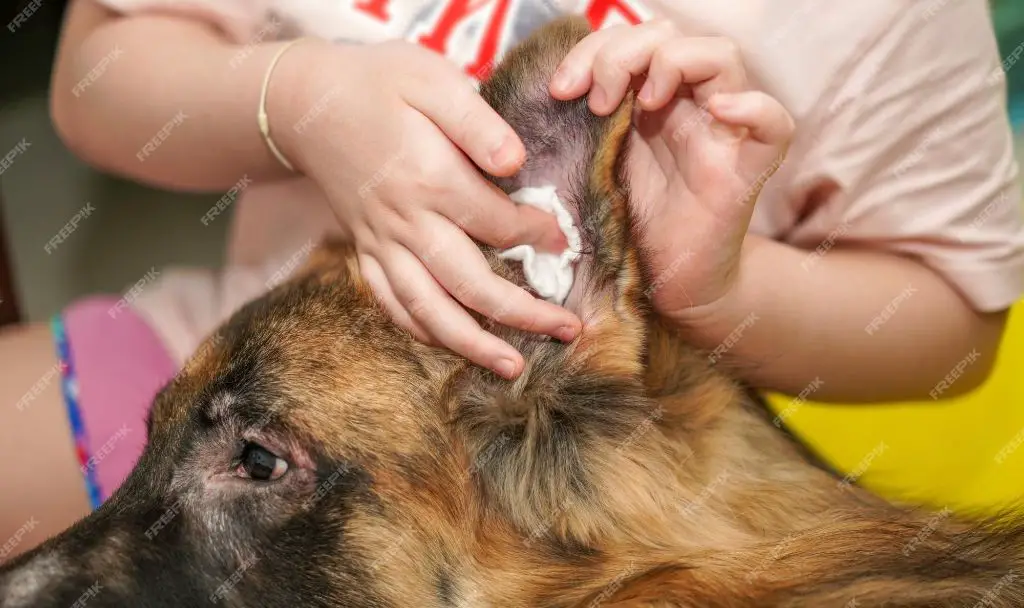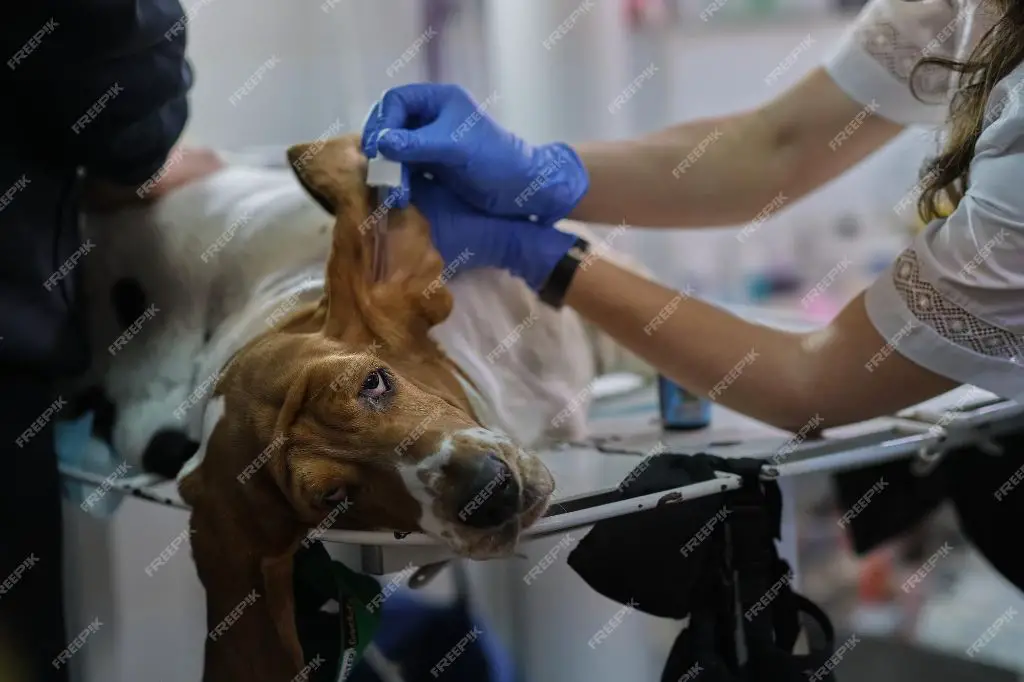Introduction to Dog Ear Cleaners
Dog ear cleaners are hygiene products formulated specifically for cleaning the ears of canines. They come in liquid, wipe, or powder form and are commonly designed to gently remove excess wax, dirt, and debris from the ears while helping to avoid irritation and infection.
The purpose of dog ear cleaners is to keep the ears healthy and free of buildup. Proper ear hygiene can prevent ear infections or allow early treatment if caught quickly. Pets rely on owners to help them maintain good ear care.
Safety is an important consideration with any cleaning product used on dogs. Some key questions include: Are the ingredients gentle enough? Could a dog have an allergic reaction? Is the product designed for regular use or only occasional use? Does it require any special application instructions to avoid injury or discomfort?
Ingredients
Dog ear cleaners typically contain some combination of the following ingredients:
- Saline solution – Helps flush out debris and dissolve wax and oil buildup. Safe for regular use.
- Glycerin – Acts as a humectant to soften and loosen dried wax and debris.
- Antifungal and antibacterial agents – Examples include acetic acid, boric acid, chlorhexadine gluconate. Help prevent yeast and bacterial infections by controlling growth.
- Surfactants – Detergents that help lift dirt, oil and wax. Common options are cetylpyridinium chloride, polysorbate 20.
- pH balancers – Help maintain the natural acidic environment of the ear canal. Citric acid and glucono delta-lactone are often used.
- Aloe vera – Soothes inflammation and calm irritated skin.
- Fragrance – Many products contain added fragrance, which some dogs may be sensitive to.
The key ingredients provide cleaning action, infection prevention, and skin soothing benefits in a formulation designed for safe regular use in dog ears.
Benefits of Ear Cleaners

Ear cleaners offer several benefits that make them a useful part of a dog’s grooming routine.
One of the main benefits is cleaning out debris, dirt, wax, and mites that can build up in a dog’s ears over time. Dogs’ ears are shaped in a way that traps and accumulates dust, pollen, moisture and other particles. Ear cleaners help flush out this debris to keep ears clean.
Regular cleaning also helps prevent ear infections by removing bacteria, yeast and other microorganisms before they can colonize and cause infection. By gently wiping away dirt and grime, ear cleaners create a cleaner environment less hospitable to infectious agents.
Finally, ear cleaners can provide a soothing effect for dogs with irritated or itchy ears. The solutions often contain gentle ingredients like aloe vera that can temporarily relieve mild discomfort associated with dirt, wax buildup or environmental allergies. However, chronic irritation or infection should be examined by a vet.
Risks of Using Dog Ear Cleaners

While dog ear cleaners can provide benefits, there are some potential risks to be aware of as well:
Potential for Allergic Reactions
Some dogs may be allergic or sensitive to ingredients commonly found in ear cleaners, such as aloe vera, propylene glycol, and dyes. Reactions can range from mild itchiness and redness, to more severe swelling of the ear canal. Discontinue use if any irritation occurs.
Overcleaning Can Dry Out Ears
Overusing ear cleaners too often can disrupt the delicate pH balance of a dog’s ear canal. This can remove protective earwax and lead to dry, itchy ears that are more prone to infections. Follow package directions carefully.
Pushing Debris Deeper
Improper cleaning with cotton swabs or by inserting the bottle tip into the ear canal can inadvertently push debris farther into the ear, worsening impaction and irritation. Only clean outer ear area gently with cotton balls.
Veterinarian Guidance

It’s always best to consult your veterinarian before using any ear cleaner on your dog. Veterinarians can examine your dog’s ears and determine if a cleaner is needed or recommend specific products. Here are some key points on frequency of use, signs of overuse, and ingredients to avoid according to vets:
Recommendations on Frequency: Veterinarians typically recommend using an ear cleaner no more than once a week in healthy dogs with normal ears. More frequent use, such as several times per week, may disturb the delicate ear environment. For dogs with ear infections or excess debris, vets may recommend more frequent cleaning while the condition is treated.
Signs of Overuse: Using ear cleaners too often can lead to dry, irritated, or inflamed ears. Signs your dog’s ears are negatively impacted include redness, swelling, scratching at ears, dark discharge, offensive odor, or sensitivity to touch. Discontinue use and see your vet if these develop.
What to Avoid: Veterinarians advise against using cleaners containing harsh ingredients like alcohol, hydrogen peroxide, strong acids or bases. These can damage the ear canal skin and disrupt the healthy ear environment. Avoid pouring cleaner directly into the ear canal. Also, never use cotton swabs, which can cause injury.
Consult with your veterinarian before regular use of any ear cleaner, and discontinue use if any adverse effects occur. Follow your vet’s guidance on proper use and frequency for your dog’s ears.
Homemade vs Commercial
When it comes to cleaning your dog’s ears, you have the option of using a commercial ear cleaner or making your own at home. There are pros and cons to each approach.
The main advantage of homemade cleaners is that you know exactly what’s going into them. Many vets recommend using a cleansing solution of equal parts water and vinegar as a gentle way to clean dirty dog ears. You can also find recipes online for homemade cleaners using ingredients like coconut oil, aloe vera, rubbing alcohol, and more. The ingredients are likely things you already have at home, so it’s convenient and affordable.
However, the downside is that it can be tricky to get the proportions right. Making it too harsh with rubbing alcohol could irritate your dog’s ears. Too much moisture might lead to infection. And homemade cleaners don’t always have the same efficacy at breaking down ear wax as commercial products designed specifically for dog ears.
The main benefits of commercial cleaners are that they are veterinarian-approved and specially formulated for safety and effectiveness on dogs. The ingredients, PH balance, and proportions are optimized by scientists and experts. This takes the guesswork out of proper cleaning. Brand name cleaners are also readily available at pet stores and online.
The potential cons are that some dogs may be sensitive to certain ingredients, and the specific ingredients are often not disclosed. Some vets advise against any cleaners containing harsh chemicals or alcohol. It’s important to follow instructions carefully and stop use if any redness or irritation occurs.
Talk to your veterinarian about whether a homemade or commercial ear cleaner is best for your dog’s ears.
How to Use Dog Ear Cleaners
When using a dog ear cleaner, it’s important to follow some basic guidelines to ensure proper administration and avoid any potential issues.
Here are some tips for safely and effectively using dog ear cleaners:
- Always inspect your dog’s ears first before cleaning. Look for any signs of redness, odor, discharge, or sensitivity. If their ears seem irritated or infected, see your veterinarian before using a cleaner.
- Shake the cleaner bottle well before each use. Then fill the ear canal with cleaner until you see it reach the outer part of the ear.
- Massage the base of the ear gently to work the solution into the canal and loosen any debris or wax buildup.
- Let your dog shake their head or use a cotton ball to absorb any excess cleaner that comes back out.
- Never use cotton swabs, which can push debris further into the ear canal.
- For most cleaners, veterinarians recommend regular use once a week to every other week. For dogs with chronic infections, ask your vet how often to use the cleaner.
- After cleaning, offer your dog praise and a treat for being patient and cooperative.
Always follow package directions and consult your veterinarian if you have any concerns about proper use of a dog ear cleaner for your pet.
Special Cases
When using dog ear cleaner, there are a few special cases to keep in mind:
Puppies
Puppies have very delicate ears that are still developing. You’ll want to be extra gentle when cleaning their ears and avoid inserting the tip of the cleaner too far into the ear canal. Stick to gentle wiping around the outer ear.
Dogs with Allergies or Infections
Dogs with allergies, yeast infections, or other ear conditions may require special medicated cleaners rather than standard products. Check with your vet on the best cleaner for your dog’s needs.
After Swimming
Dogs who swim frequently or play in water can get excess moisture and debris trapped in their ears. It’s a good idea to gently wipe out and dry their ears after water activities to prevent infection.
Signs of Trouble

Using an ear cleaner improperly or too frequently can lead to some concerning signs. Be on the lookout for these issues, as they may indicate an underlying problem that requires veterinary attention:
Redness – If your dog’s ears become red and inflamed after using a cleaner, they may have developed an allergy or sensitivity to one of the ingredients. Discontinue use and monitor their ears closely.
Head shaking – Excessive head shaking or scratching at their ears after application likely signals discomfort or irritation. The cleaner may be too harsh or drying for their delicate ear canal.
Odor – A foul odor emanating from your dog’s ears, even after cleaning, can indicate the presence of infection. Have your vet examine your dog’s ears and prescribe medication if necessary.
If you notice any of these symptoms, stop using the ear cleaner until you can identify the underlying cause. Persisting with a product that is aggravating your dog’s ears will only worsen the problem.
Conclusion
Using a dog ear cleaner appropriately can provide many benefits, but there are also some risks to be aware of. The key ingredients like witch hazel, aloe vera, and coconut oil can gently clean debris and waxy buildup from your dog’s ears when used as directed. However, overuse or getting solution into the inner ear can disturb their sensitive balance and hearing. It’s critical to consult your veterinarian, follow instructions carefully, and watch for any signs of trouble. With proper precautions, a quality dog ear cleanser can be a useful part of keeping your canine companion happy and healthy.